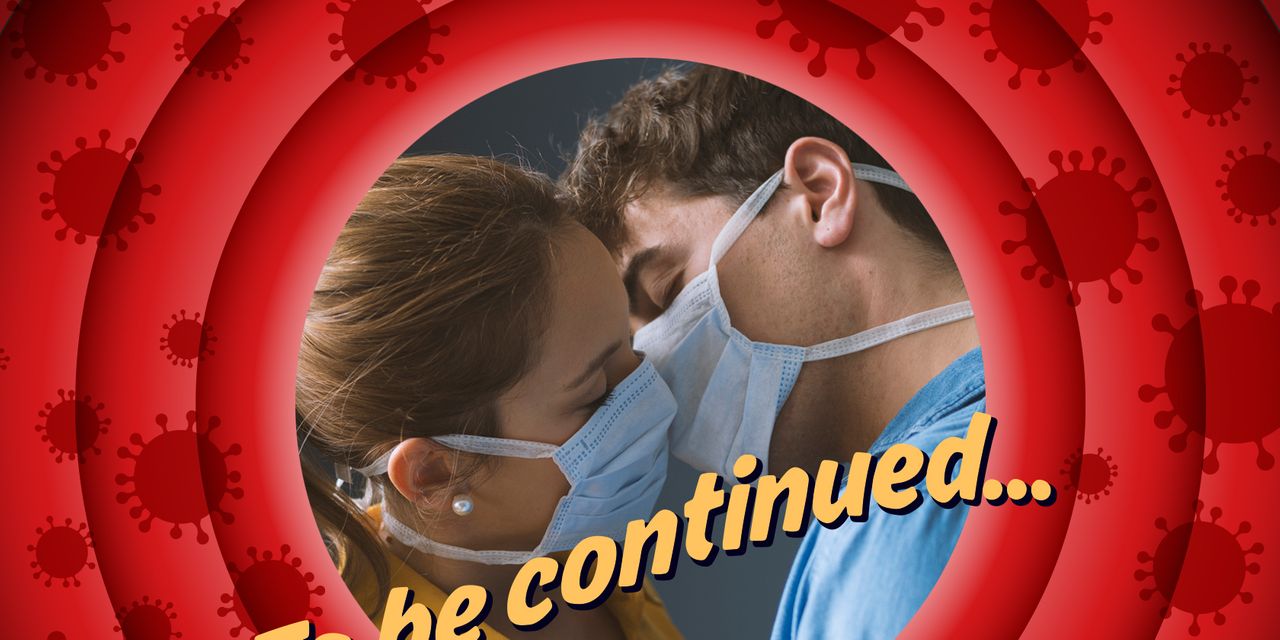
The coming months will be messy, frustrating and prolonged — just like the coronavirus pandemic story so far.
The long, slow march of the pandemic was always going to be slightly messy, given people’s wavering approach to risk, vaccine hesitancy and increased socializing, not to mention relaxation of handwashing, mask wearing and COVID-related social-distancing practices.
The expectation of herd immunity making the world much safer may be a fine goal, health professionals say, but it’s not entirely a realistic one given the number of people who will not get vaccinated due to fears about side effects or for other political and ideological reasons.
And how can the U.S. return to relative normalcy when parts of the developing world, and notably India, have descended into hellish conditions in which vaccinations have not kept pace with the escalating rate of infections and deaths, and oxygen is in short supply? The Biden administration restricted travel from India beginning Tuesday due to “extraordinarily high” caseloads and multiple variants.
“I am afraid that our vision of life returning ‘to normal’ sometime this summer is slipping out of reach,” said Dr. Andrew Pavia, the George and Esther Gross Presidential Professor at the University of Utah and head of the university hospital’s pediatric infectious-diseases unit.
“ ‘The whole world changed in a couple of days. Getting back is going to be a whole lot more complicated.’ ”
“That vision depends on reaching a really high level of population immunity so that the virus is not consistently spreading,” he said. “It is likely that Israel will see the kind of suppression of COVID that we dream of. We probably will not unless we do better.”
As the U.S. continues to ramp up vaccinations to those who want to get them, the rollout has been much slower in Europe. Other countries, meanwhile, have barely gotten started. In the U.S., 32% of the total population is fully vaccinated and more than 44% have received at least one dose, according to the Centers for Disease Control and Prevention.
“When I think back to a year ago, the whole world changed in a couple of days,” said Dr. Preeti Malani, chief health officer in the divisions of infectious diseases and geriatric medicine at the University of Michigan and a fellow of the Infectious Diseases Society of America. “Getting back is going to be a whole lot more complicated.”
With 32.5 million recorded infections, the U.S. has the world’s highest total caseload of SARS-CoV-2, the virus that causes the disease COVID-19, more than the official counts from India (20.3 million), Brazil (14.8 million) and France (5.7 million). The U.S. also has the most confirmed COVID-related fatalities (578,292).
Coronavirus Update: India becomes second country with case tally above 20 million
“There is a next phase in sight, if not an end in sight. COVID may not be completely gone, but it will be in the background,” Malani added. “Being on a happy hour on Zoom ZM, -2.89% is not the same thing as being together on someone’s patio, but it’s OK short term. Humans need to be with humans.”
Like Dr. Anthony Fauci, President Joe Biden’s chief medical adviser and the head of the National Institute of Allergy and Infectious Diseases, Malani said that “herd immunity” is not a term she is entirely comfortable with.
Once the first wave of vaccinations is complete, it will be hard to convince the holdouts to get the vaccine, she said — and progress won’t happen evenly.
“The focus needs to be on preventing outbreaks and getting people vaccinated,” she said. “There will be communities where the vaccination rates will be very high, but if you drive 50 miles in another direction, there will be very low vaccination rates. In my community [in Michigan], I anticipate that the summer and fall will look a lot more normal.”
See: Pfizer COVID-19 vaccine expected to get FDA authorization for 12- to 15-year-olds next week
The fifth pandemic in 100 years
Pavia is not so sure. “I am less sanguine that we can open up in a gradual and thoughtful way, given the politics and fatigue,” he said. And if we don’t? “Most states will have low to moderate ongoing transmission and death, with periodic spikes and superspreader events.”
“Some level of background transmission is probably inevitable, but the question is how much suffering are we going to have to put up with,” he added.
Indeed, people have different reactions to the perceived risk depending on the government’s policies restricting or not restricting economic activity during COVID-19, according to a paper released this week by a team of researchers at Stanford University; Duke University; and Westat Inc., a data-research firm in Rockville, Md.
Consumers who believe that they face a higher risk of infection are more likely to report avoiding economic activities, and yet government rules restricting economic behavior reduce that relationship between perceived risk and protective behaviors, they found.
“ ‘Most states will have low to moderate ongoing transmission and death, with periodic spikes and superspreader events.’ ”
As for a slow winding down where everyone is vaccinated and people act according to CDC guidance, “it isn’t going to happen,” Dr. Gregory Poland, who studies the immunogenetics of vaccine response at the Mayo Clinic, told MarketWatch.
“There is no nice, neat bow to tie this up. We have already rejected that,” he said. “Other countries have not. You can go to New Zealand and Australia: no masks, because they decided to take a science- and evidence-based approach. We, for the most part, have not.”
People are complicated and unpredictable, Poland said. “We will have on-again, off-again outbreaks — just like we had after the holidays, despite the warnings,” he added. “We are just coming out of the spring-break surge. The wise among us who are eligible have gotten vaccinated.” Some people from marginalized or underserved communities have also faced structural barriers to vaccine access.
“I wrote a thesis on the plagues of the 1500s and 1600s in Britain,” Poland said. “Martin Luther wrote a letter about how to manage the [bubonic] plague that was raging through England. He said, ‘I will distance myself from people who have the sickness.’ ”
“They were doing all the things that we are still arguing about 500 or 600 years later. George Bernard Shaw said the one thing we should learn from history is that we never learn from history. People engaging in political and economic manipulation prolonged this.”
“If we had said in February [that] everyone should wear a mask, this would be done and over with,” Poland added. “But 1 out of 575 of us is dead from a disease that we could have prevented. When you lay out the cold, hard facts, you throw up your hands and say this is irrational.”
This is the fifth pandemic in the last 100 years, Poland said, citing the 1918 flu pandemic, 1957 “Asian flu,” 1968 “Hong Kong flu,” the AIDS pandemic and 2009 swine flu pandemic. And there were near-misses with Zika, Ebola and Middle East Respiratory Syndrome, or MERS.
Poland said writers like John Barry, author of “The Great Influenza: The Story of the Deadliest Pandemic in History,” did a forensic analysis of previous pandemics that the world could — and should — have learned. One of the many takeaways: During the 1918 influenza pandemic, which killed an estimated 50 million people, wealthier people had a better chance of survival.
‘Pathologically narcissistic culture’
In 2021, poorer countries are, for the most part, bearing the brunt. Until enough people are vaccinated, experts warn, countries will institute ad hoc isolationist policies to protect themselves from rising infections elsewhere. The latest such measure: Australia told citizens not to return from India, or be prepared to face fines and possible jail time.
Travel bans on citizens of certain other countries will likely persist. “There will always be risk of reintroductions from overseas until we have vaccine equity, but in a highly vaccinated population, those reintroductions would have a hard time spreading,” Pavia said.
“I try to be an optimist in spite of what we have seen in the last year,” he added. “I hope we can continue to make vaccines readily available to those for whom access is challenging, continue to answer people’s fears and questions to increase confidence.”
The politicization of the pandemic and people’s drastically different reactions to it across the country will be less easy to solve, Poland said. And how countries act in a global context is critical. “To be isolationist is wrong. Until the globe is vaccinated, none of us is safe,” he said.
“ ‘People with zero knowledge of science feel very safe and comfortable sharing that ignorance with others.’ ”
On Monday, Moderna MRNA, -6.68% said that it will supply 34 million doses of its COVID-19 vaccine to the Covax initiative, an organization of Western governments to deliver vaccines to 92 low- and middle-income countries and economies. The Pfizer-BioNTech partnership PFE, +0.30% BNTX, -15.33% and AstraZeneca AZN, -1.43% had already signed up.
In the U.S., some states have dangled economic activity and social mobility as the carrots, and the vaccination rate as the stick, pledging to lift restrictions based on the amount of people who get the shot. With 55% of the population vaccinated, in-person work will be allowed in Michigan, and so on as more people get vaccinated.
“If you haven’t accepted the pandemic as being a significant issue, and you don’t want to be vaccinated, then maybe you haven’t been taking significant precautions,” Malani told MarketWatch. “I feel like things will move in different directions across the board.”
“In some places, things already look pretty much normal. I’m starting to see that in Ann Arbor, but in responsible ways. There’s something comforting about that. Everything that’s outdoors will go back to normal sooner. Indoors will be a slower process.”
She is hopeful that people will learn from 2020. “The culture has shifted around if you are sick, you don’t come to work or go to an event,” Malani said. “Before COVID, people went to work sick. Some of those things will stay with us. Each day, week and month we learn more.”
“High-school seniors are having graduation ceremonies, and they’re having proms, but they’re doing it outside and they’re doing it after they’ve been vaccinated,” she added. “Campuses are starting to look more like a normal campus, and that makes me very happy.”
Poland feels less confident. He believes there needs to be a fundamental shift in American thinking and a rethinking of American exceptionalism for sustainable, long-term progress to happen. “We are a pathologically narcissistic culture. We are a ‘me’ not a ‘we’ culture. How did they manage to handle it so well in Asian countries? They are a ‘we’ society.”
He blames “scientific illiteracy and the false notion of democratization of expertise” and said we should put scientific knowledge first. “People with zero knowledge of science feel very safe and comfortable sharing that ignorance with others, and making decisions based on that ignorance.”
“When you reject science as a way of knowing, then you end up where we are,” he added. “Who are we as a culture that we were so prone to that? How is that possible? It’s just a tragedy. I truly believe that the John Barrys 100 years from now will be at their wits’ end trying to explain this.”





